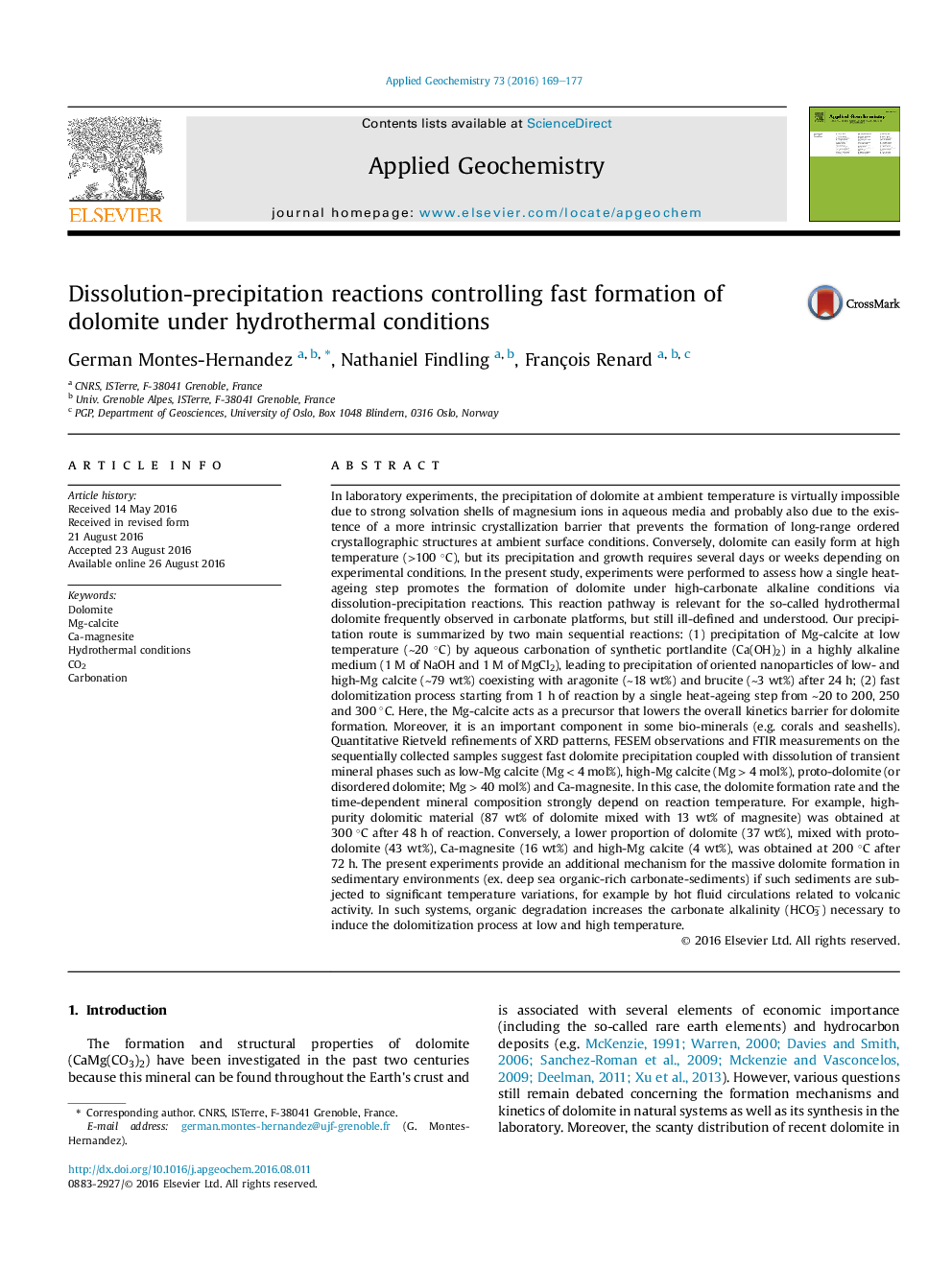| کد مقاله | کد نشریه | سال انتشار | مقاله انگلیسی | نسخه تمام متن |
|---|---|---|---|---|
| 4435547 | 1620218 | 2016 | 9 صفحه PDF | دانلود رایگان |
• Single heat-ageing step promotes the formation of dolomite under alkaline conditions.
• Mg-calcite and proto-dolomite act as precursors for dolomite formation.
• Dolomite formation kinetics and temporal mineral composition depend on reaction T.
In laboratory experiments, the precipitation of dolomite at ambient temperature is virtually impossible due to strong solvation shells of magnesium ions in aqueous media and probably also due to the existence of a more intrinsic crystallization barrier that prevents the formation of long-range ordered crystallographic structures at ambient surface conditions. Conversely, dolomite can easily form at high temperature (>100 °C), but its precipitation and growth requires several days or weeks depending on experimental conditions. In the present study, experiments were performed to assess how a single heat-ageing step promotes the formation of dolomite under high-carbonate alkaline conditions via dissolution-precipitation reactions. This reaction pathway is relevant for the so-called hydrothermal dolomite frequently observed in carbonate platforms, but still ill-defined and understood. Our precipitation route is summarized by two main sequential reactions: (1) precipitation of Mg-calcite at low temperature (∼20 °C) by aqueous carbonation of synthetic portlandite (Ca(OH)2) in a highly alkaline medium (1 M of NaOH and 1 M of MgCl2), leading to precipitation of oriented nanoparticles of low- and high-Mg calcite (∼79 wt%) coexisting with aragonite (∼18 wt%) and brucite (∼3 wt%) after 24 h; (2) fast dolomitization process starting from 1 h of reaction by a single heat-ageing step from ∼20 to 200, 250 and 300 °C. Here, the Mg-calcite acts as a precursor that lowers the overall kinetics barrier for dolomite formation. Moreover, it is an important component in some bio-minerals (e.g. corals and seashells). Quantitative Rietveld refinements of XRD patterns, FESEM observations and FTIR measurements on the sequentially collected samples suggest fast dolomite precipitation coupled with dissolution of transient mineral phases such as low-Mg calcite (Mg < 4 mol%), high-Mg calcite (Mg > 4 mol%), proto-dolomite (or disordered dolomite; Mg > 40 mol%) and Ca-magnesite. In this case, the dolomite formation rate and the time-dependent mineral composition strongly depend on reaction temperature. For example, high-purity dolomitic material (87 wt% of dolomite mixed with 13 wt% of magnesite) was obtained at 300 °C after 48 h of reaction. Conversely, a lower proportion of dolomite (37 wt%), mixed with proto-dolomite (43 wt%), Ca-magnesite (16 wt%) and high-Mg calcite (4 wt%), was obtained at 200 °C after 72 h. The present experiments provide an additional mechanism for the massive dolomite formation in sedimentary environments (ex. deep sea organic-rich carbonate-sediments) if such sediments are subjected to significant temperature variations, for example by hot fluid circulations related to volcanic activity. In such systems, organic degradation increases the carbonate alkalinity (HCO3−) necessary to induce the dolomitization process at low and high temperature.
Journal: Applied Geochemistry - Volume 73, October 2016, Pages 169–177
